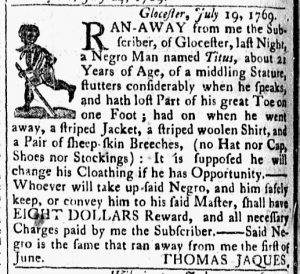What was advertised in a colonial American newspaper 250 years ago today?

“RAN-away … a Negro Man named Titus.”
Titus was determined to make his escape from Thomas Jaques, the man who enslaved him. He fled sometime during the night of October 18, 1769, prompting Jaques to pen a notice to insert in the next several issues of the Essex Gazette. Based on the description in the advertisement, Titus would have been difficult to miss if any readers encountered him. According to Jaques, Titus “stutters considerably when he speaks, and hath lost Part of his great Toe on one Foot.” Perhaps most significantly, he also “had a Span of Iron, with a Chain fastned to it on one Leg.” The chain may have been part of an unsuccessful effort to prevent Titus from making his escape. After all, Jaques had some experience with Titus attempting to seize his own liberty. Just a few months earlier, in advertisements dated July 19, Jaques described Titus and offered a reward for his return. He indicated in his new advertisement that “Said Negro is the same that ran away from me the middle of July.”
That Titus had once again found himself under the thrall of Jaques suggests that the advertisement placed in the summer produced results. Jaques did not explain how he managed to capture Titus, but he apparently considered advertising an effective tool because he resorted to it once again. Such advertisements serve as narratives of resistance that often lack definitive conclusions. Modern readers can hope that enslaved people like Titus made good on their escapes, but often the documentary record does not include evidence one way or the other. This particular advertisement does confirm that, unfortunately, Titus did not managed to remove himself from the grasp of Jaques. Yet it also reveals that Titus was not deterred by that setback. He tried again …
… and again and again. Molly O’Hagan Hardy has identified two other advertisements about Titus’s attempts to escape, one from 1772 and the other from 1773. In addition to those instances, Lise Breen has documented two others. As colonists transitioned from resistance to revolution, Titus again fled from his enslavers in 1774 and 1775. Again, newspaper advertisements may have been effective in helping to capture Titus and return him to those who held him in bondage. Advertisements describing him, offering rewards, and warning “Masters of Vessels” against “harbouring, concealing, or carrying off said Negro” appeared alongside news about colonists demanding their liberty and editorials excoriating Parliament for its abuses. Through it all, Titus embodied a revolutionary spirit, repeatedly seeking his own freedom from bondage.

